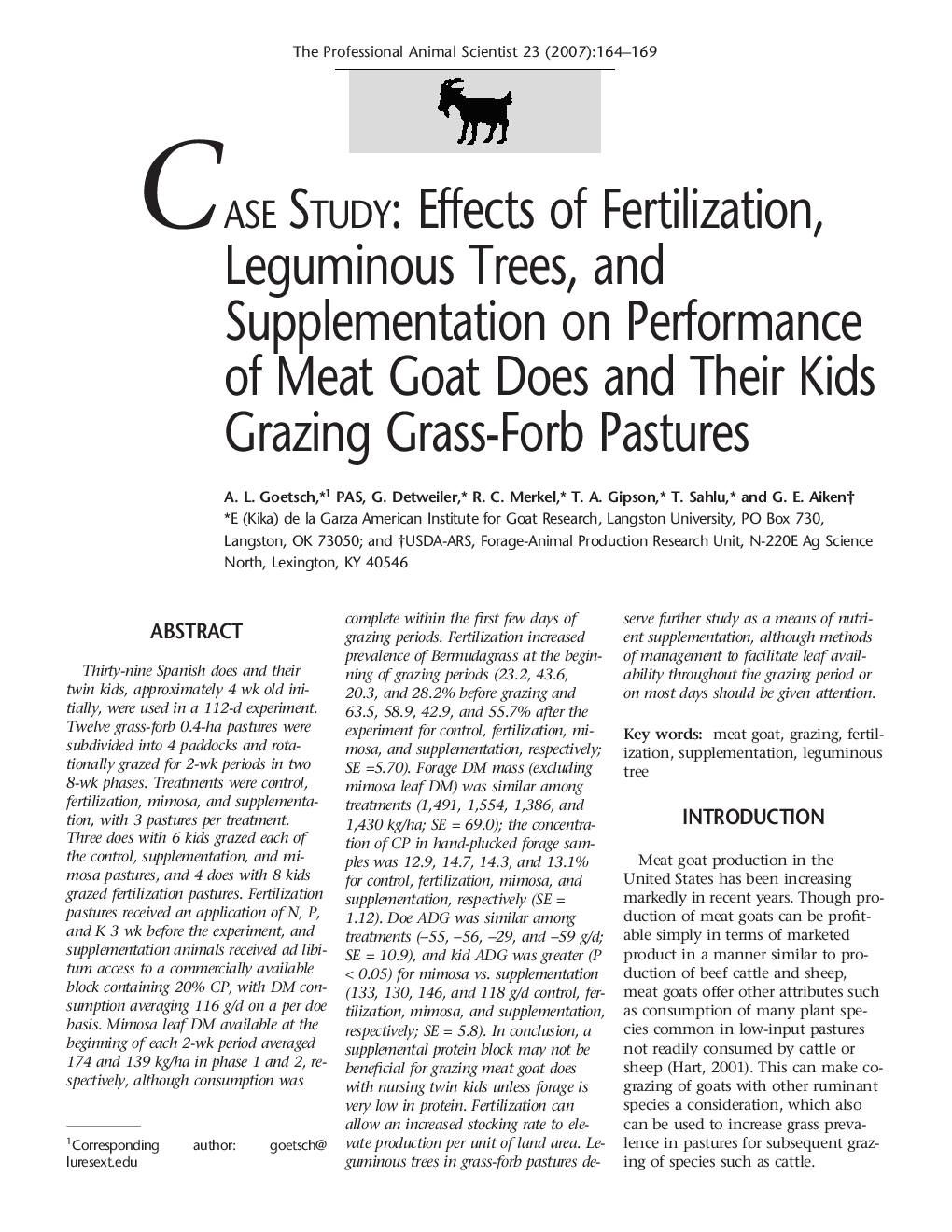| کد مقاله | کد نشریه | سال انتشار | مقاله انگلیسی | نسخه تمام متن |
|---|---|---|---|---|
| 2454655 | 1110406 | 2007 | 6 صفحه PDF | دانلود رایگان |
عنوان انگلیسی مقاله ISI
Effects of Fertilization, Leguminous Trees, and Supplementation on Performance of Meat Goat Does and Their Kids Grazing Grass-Forb Pastures
دانلود مقاله + سفارش ترجمه
دانلود مقاله ISI انگلیسی
رایگان برای ایرانیان
کلمات کلیدی
موضوعات مرتبط
علوم زیستی و بیوفناوری
علوم کشاورزی و بیولوژیک
علوم دامی و جانورشناسی
پیش نمایش صفحه اول مقاله

چکیده انگلیسی
Thirty-nine Spanish does and their twin kids, approximately 4 wk old initially, were used in a 112-d experiment. Twelve grass-forb 0.4-ha pastures were subdivided into 4 paddocks and rotationally grazed for 2-wk periods in two 8-wk phases. Treatments were control, fertilization, mimosa, and supplementation, with 3 pastures per treatment. Three does with 6 kids grazed each of the control, supplementation, and mimosa pastures, and 4 does with 8 kids grazed fertilization pastures. Fertilization pastures received an application of N, P, and K 3 wk before the experiment, and supplementation animals received ad libitum access to a commercially available block containing 20% CP, with DM consumption averaging 116 g/d on a per doe basis. Mimosa leaf DM available at the beginning of each 2-wk period averaged 174 and 139 kg/ha in phase 1 and 2, respectively, although consumption was complete within the first few days of grazing periods. Fertilization increased prevalence of Bermudagrass at the beginning of grazing periods (23.2, 43.6, 20.3, and 28.2% before grazing and 63.5, 58.9, 42.9, and 55.7% after the experiment for control, fertilization, mimosa, and supplementation, respectively; SE =5.70). Forage DM mass (excluding mimosa leaf DM) was similar among treatments (1,491, 1,554, 1,386, and 1,430 kg/ha; SE = 69.0); the concentration of CP in hand-plucked forage samples was 12.9, 14.7, 14.3, and 13.1% for control, fertilization, mimosa, and supplementation, respectively (SE = 1.12). Doe ADG was similar among treatments (â55, â56, â29, and â59 g/d; SE = 10.9), and kid ADG was greater (P < 0.05) for mimosa vs. supplementation (133, 130, 146, and 118 g/d control, fertilization, mimosa, and supplementation, respectively; SE = 5.8). In conclusion, a supplemental protein block may not be beneficial for grazing meat goat does with nursing twin kids unless forage is very low in protein. Fertilization can allow an increased stocking rate to elevate production per unit of land area. Leguminous trees in grass-forb pastures deserve further study as a means of nutrient supplementation, although methods of management to facilitate leaf availability throughout the grazing period or on most days should be given attention.
ناشر
Database: Elsevier - ScienceDirect (ساینس دایرکت)
Journal: The Professional Animal Scientist - Volume 23, Issue 2, April 2007, Pages 164-169
Journal: The Professional Animal Scientist - Volume 23, Issue 2, April 2007, Pages 164-169
نویسندگان
A.L. PAS, G. Detweiler, R.C. Merkel, T.A. Gipson, T. Sahlu, G.E. Aiken,